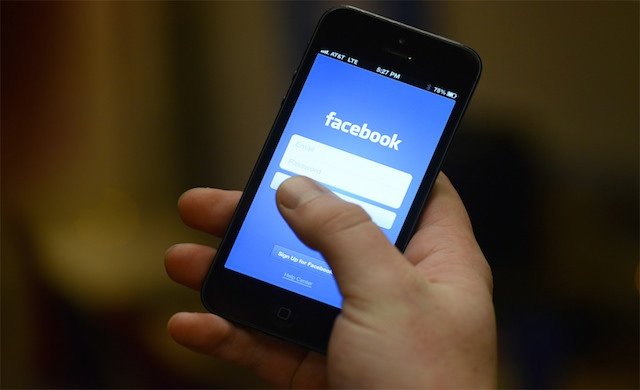
Launching your app can be both exciting and extremely stressful. Given the amount of time (and money) you’ve spent developing it, you want to make sure it’s a success. And the first step to app success is earning users. That’s where Facebook can help. With its highly targeted advertising capabilities, easy set-up, and high visibility into performance, Facebook’s mobile ads can help you accumulate a sizable user base. More importantly? Facebook Ads are the number one source of paid traffic to convert for paid app downloads.
But because of its massive reach, Facebook is also highly saturated with ads so you have to be careful otherwise your ad might get lost in the shuffle.
How can you ensure your Facebook ads stand out? Read on to find out exactly what you need to do to create a successful Facebook ad acquisition campaign for your app:
How to Build A Facebook User Acquisition Campaign
1.) Know Your Goal: Before you launch any advertising campaign, you need to clearly identify the objective for doing so. Are you trying to:
- Increase brand awareness?
- Remarket to lapsed users?
- Acquire new app users?
- Increase engagement in your app?
- Get people to claim your offer?
- Send people to your app’s website?
There are many reasons to advertise, but I’m going to make this simple for you. If you’re launching an app, here’s your goal:
Goal: to acquire as many new, high-quality users as possible
Setup Tip: When you’re setting up your ad in Facebook’s ad manager, choose, “Get installs of your app.” Then, you can link to your App Store profile so that your audience will be directed to it upon clicking on your ad.
2.) Know Your Audience: Much like knowing your goal, it’s equally as important to know your audience. Facebook has a staggering amount of users (over 1.5 billion), so be as explicit as possible when setting up audience parameters. Facebook’s audience reach is intricate, and allows you to target users at a granular level from age, gender, location, interests, job title, and more. Play around with it, and make sure it encompasses all elements of your target audience. The more tailored the better, so you can ensure your ads display for those most inclined to download.
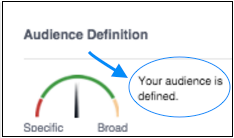
Setup Tip: Facebook’s Audience Definition ticker will tell you if your audience is broad or more defined. Make sure you’re in the green and it says, “Your audience is defined.”
Chances are you have more than one target audience. That’s where Facebook ads become even more powerful, allowing you to run custom ad campaigns based on your audience. Check out the below examples of three different ad campaigns you can run based on your target audience:
Sample Campaign #1: Winning Young Professionals for Your Ridesharing App
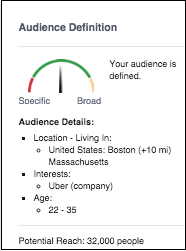
- Defined Target Audience: Young professionals who live within 10 miles of Boston and have identified Uber as an interest
- Location: We want to target people close to or within the city who are are less likely to own a car
- Gender: Both
- Interests: If they’re a fan of Uber, they’re much more likely to be interested in a ridesharing program
- Visual: Young professional looking inspired and ready to take on the world and a tagline that clearly states the value of the service.
- Best in class ad visual example: Uber
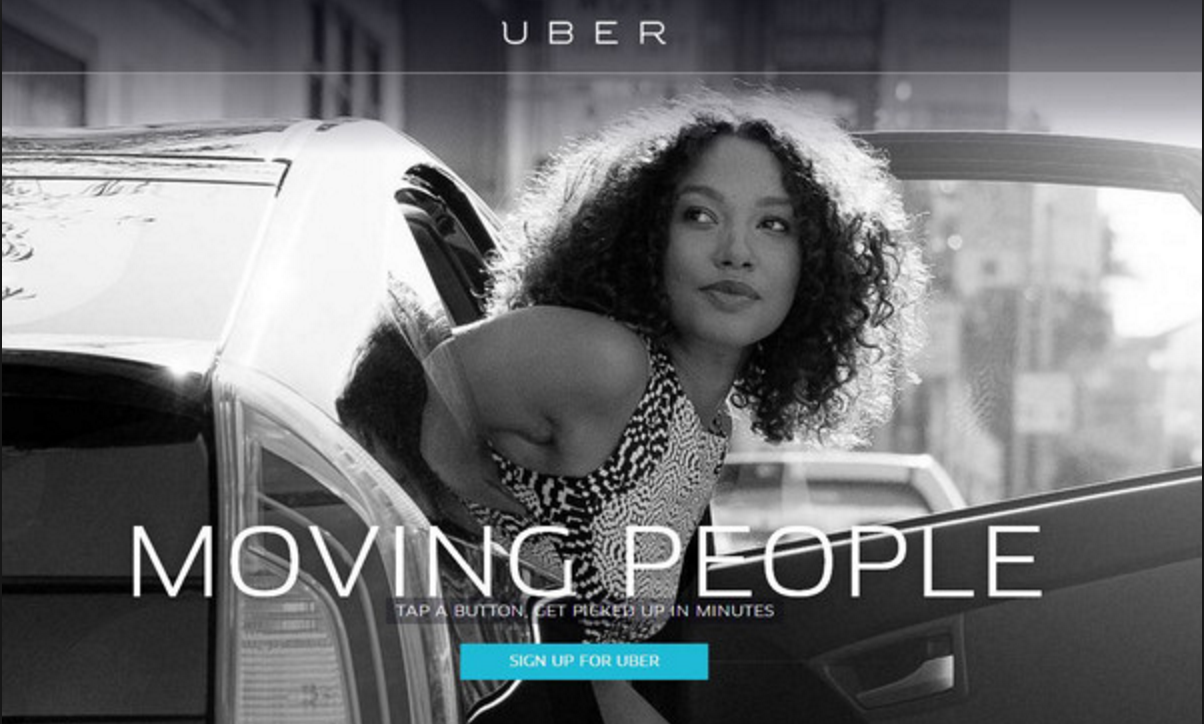
Sample Campaign #2: Winning College Students for Your Ridesharing App
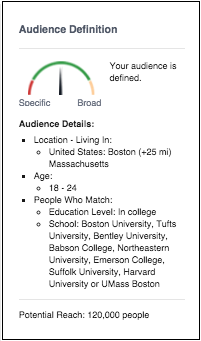 Defined Target Audience: Students currently enrolled at certain colleges in or near Boston
Defined Target Audience: Students currently enrolled at certain colleges in or near Boston
- Location: Within 25 miles of Boston, since some of these colleges are outside of the city
- Gender: Both
- Profile: Their education level is, “in college” and their profile lists them as being in one of these 9 Boston colleges
- Visual: College students are busy and on a budget, so why not lead with clean visuals detailing an enticing offer?
- Best in class ad visual example: Lyft
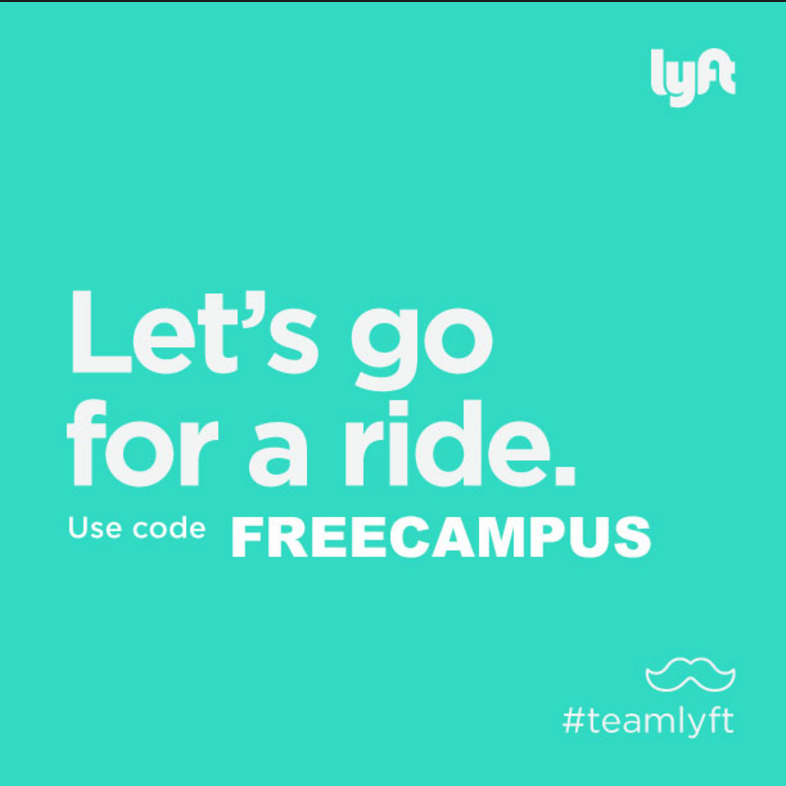
Sample Campaign #3: Winning Executives for Your Ridesharing App
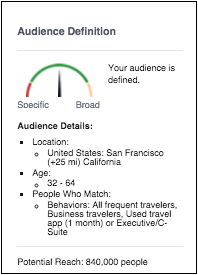
- Defined Target Audience: Executives who live near Boston and travel frequently
- Location: Within 25 miles of Boston because many of these executives might live in the suburbs with their family
- Gender: Both
- Behavior: Executives who identified as frequent travelers, business travelers, and have used a travel app within the past monthly.
- Visual: Most executives travel frequently, so the visual should call this out and entice them to try a new way to travel by leading with your key differentiator.
- Best in class ad visual example: Uber
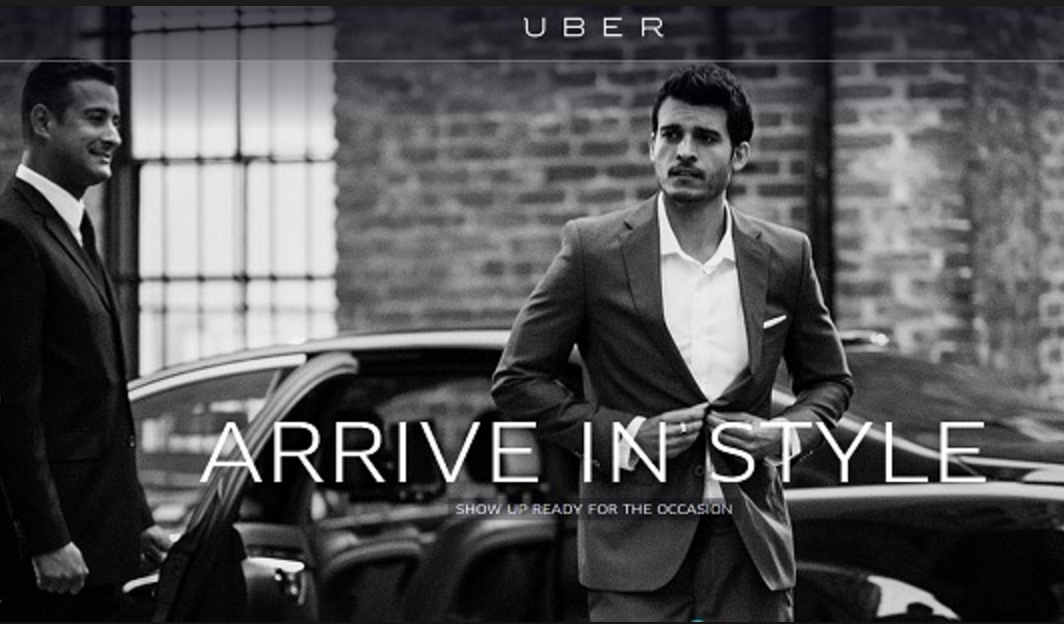
3.) Make Your Ad Count: As showcased in the above examples, having a killer Facebook ad is critical to the success of your campaign, so don’t breeze past it. Your ad is a representation of your brand and thus should embody its look and feel. At the same time, research tells us that you have eight seconds to grab someone’s attention, so your ad must be both eye-catching and succinct.
- Ad Image: They say a picture is worth 1,000 words, and your ad’s photo should be worth no less. Make sure your image is vibrant and tells the story you want it to.
- Headline: The headline is where you have a mere 25 characters to make an impact and convince people to read the rest of your ad. Choose your words wisely and make sure it’s attention grabbing.
- Copy-text: Here is where you succinctly state the value of your app and/or offer details. You only have 90 characters to get your message across, so be impactful but get to the point. Even better if it’s said cleverly.
- CTA: Don’t underestimate the power of a good CTA. Using strong action words related to your app.
Facebook Ad Setup Tip: Facebook allows you to either select one image or multiple. Multiple images can be a better option for app’s stories that are a bit more difficult to tell.
Check out these two solid Facebook app acquisition ads from Tablelist and Wallop for inspiration:
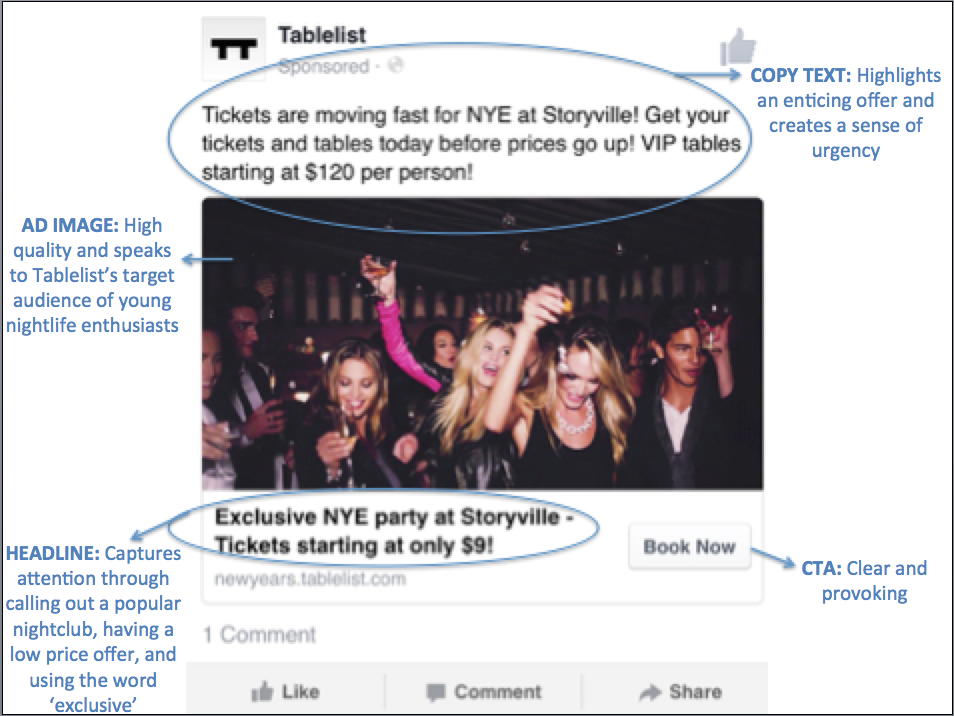
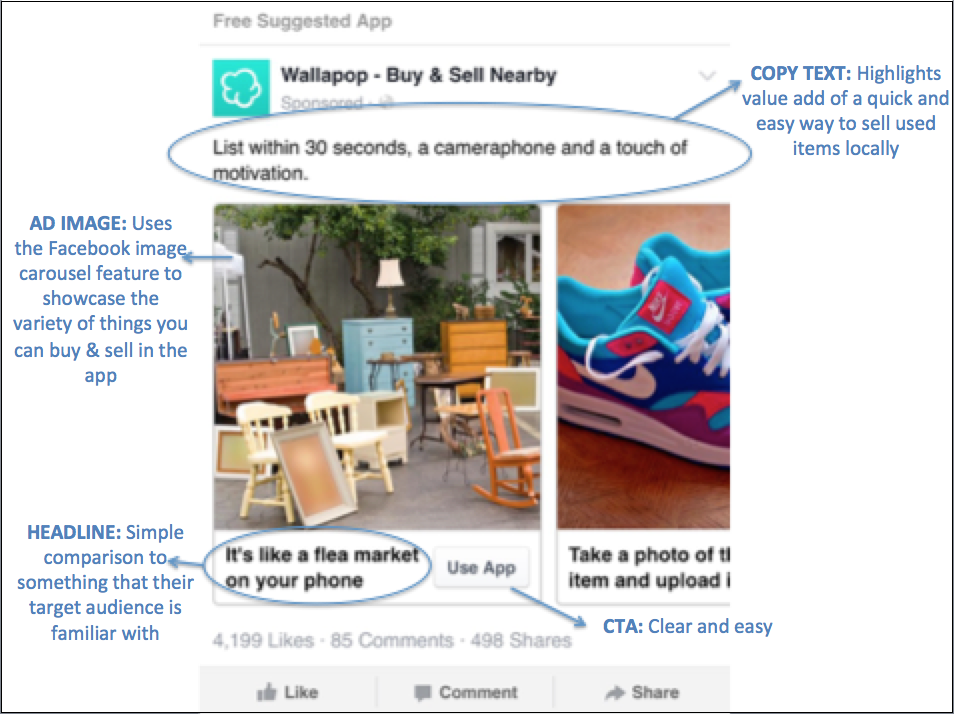
How to Measure Your Facebook Acquisition Campaign
1.) Understand What Rhe Metrics Are Telling You: With any goal set, there are caveats to look out for. You’ve heard us say that app downloads are a vanity metric, and that’s because if the people flocking to your app are also quickly churning, your efforts are wasted. Facebook tracks your ad success through a number of standard Key Performance Indicators (KPIs). Below, we define those KPIs and provide industry benchmarks for comparison:
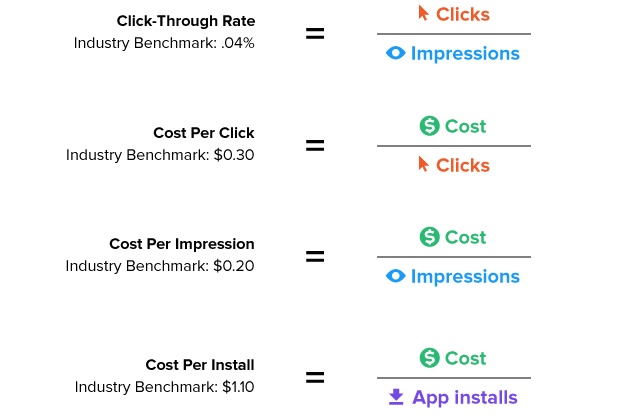
*Industry Benchmarks from Salesforce Marketing Cloud
While the above metrics are a great starting point for measuring the success of your campaign, they don’t depict the real value of these newly acquired users. To calculate this, you need to move beyond the above surface-level metrics and determine the Lifetime Value of these newly acquired users:

2.) The Significance of LTV: Measuring the LTV of users acquired by your Facebook app acquisition campaign will reveal the truth behind whether or not it’s successful in the long run. This is because it’s not only essential to acquire users, but quality ones who will continue to engage with you and complete key conversion events time and time again. Calculating the Lifetime Value of users acquired from your Facebook campaign will determine if you’re attracting the right ones, and thus getting a healthy ROI.
Take a look at the below Lifetime Value example from our Localytics platform. Here it highlights two current Facebook campaigns running:
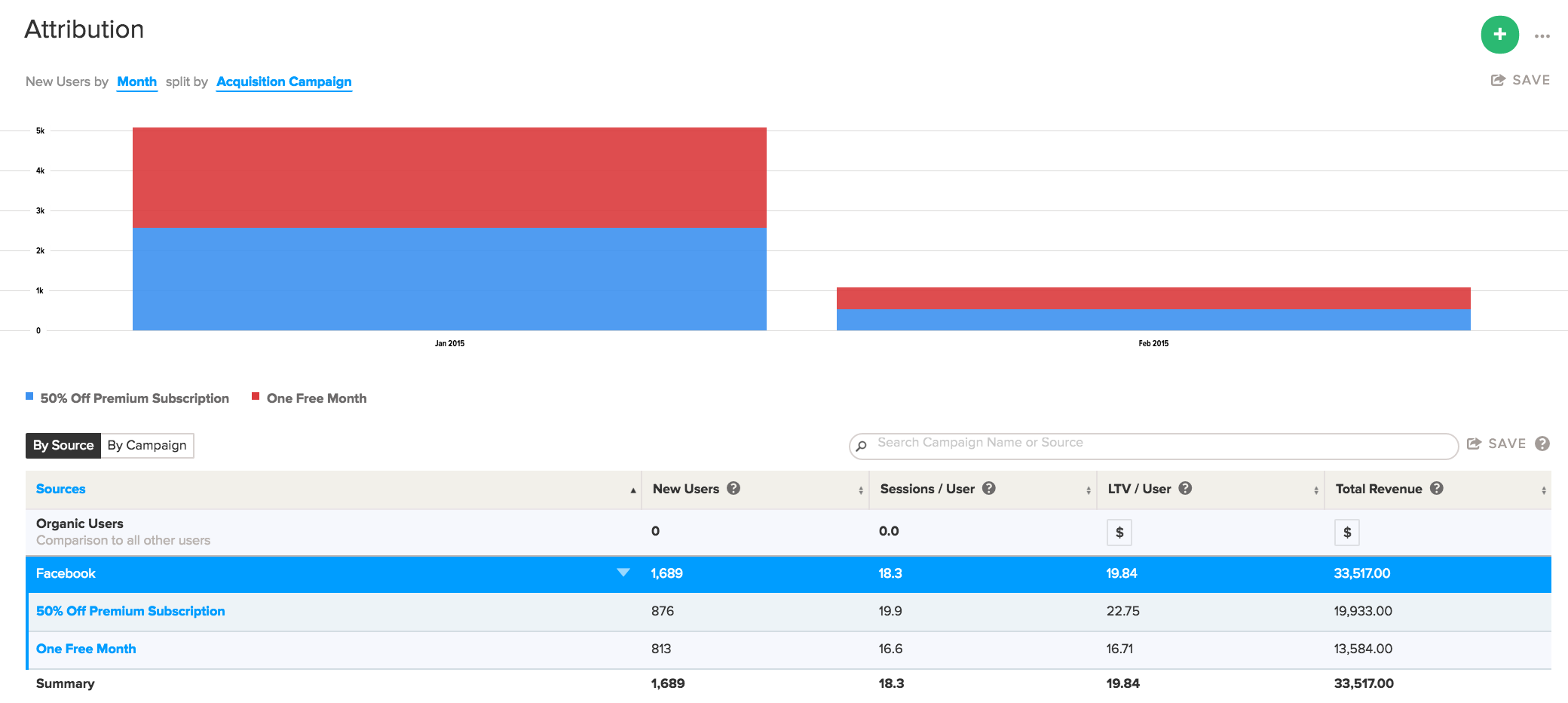
From the data found in Localytics, you can then do your own analysis on the the success of your ads. The below spreadsheet gives us a side-by-side comparison of both ads, taking into consideration the cost of each campaign, the total discount given from each offer, as well as the revenue generated after taking into consideration discount and acquisition cost:

The two campaigns are close, but users acquired from the “50% Off Your First Month” campaign have more sessions and a higher LTV than those from the “Free Month” one. This is so important because a marketer might assume that a bigger discount will drive more engaged users, but this is not the case. The above scenario exemplifies the significance of calculating LTV by granting us insight into the true measurement of app acquisition campaign success; long-term app growth.
3.) Invest in an Analytics Platform That Allows You to Accurately Track The Above Metrics: Unsurprisingly, not all mobile analytics platforms are created equal. Do your research and ensure you’re investing in one that gives you deep insights into all of the above metrics, especially Lifetime Value. Having access to rich user data will help you run more targeted, successful app acquisition campaigns and retain these users through engaging, personalized marketing campaigns. This will undoubtedly set you up for long term, post acquisition success.
Pro Tip: For more information about the significance of LTV, check out this great article on the subject.
How to Optimize Your Facebook Acquisition Campaign
Now that you understand how to measure for success, you can optimize accordingly. Facebook makes tweaking and testing ads very easy to do, so take advantage of it. Below are some optimization tactics you should consider running:
1.) A/B (Split) Testing: A/B (or split) testing is running different ads at the same time to see which performs better. Here’s a breakdown on how to best execute with A/B testing:
- Change one thing at a time: If you run drastically different ads, how are you supposed to account for which element is driving the uptick in performance? To better keep track, change one part of your ad at a time (photo, headline, copy-text) so you can easily pinpoint what drove the winning variation.
- Keep audiences the same: Much like only changing one thing at a time for your ad, you want to keep your target audience profiles the same. The reason being is if you change your audience, then you can’t accurately pinpoint which ad is more successful since different audiences may react differently.
- Run different offers: If your ad includes some kind of incentive for new users to sign-up, try running two different offers to see which is getting you more traction.
2.) Segment Campaigns by Audience: While we showed you a few examples on how to segment by different audiences with our Ridesharing App example above, there are many more to explore. Facebook has such a granular audience reach tool so take advantage of it and try running your ads for different audiences to see which are responding best. A/B testing also comes in handy here, as you can run different ad campaigns for different audiences to further gauge performance. The significance in doing so is to get as close to possible to your ideal audience. Below are some ways you can segment ads:
- Location based: Knowing where someone lives is a huge advantage when advertising to them. You can create ads relative to their city; such as local interests, events, seasonality, and more. Geotargeted ads give targeted audiences the feeling of a highly personal, 1:1 marketing.
- Gender: Taking into consideration the gender of your audience, you may want to change the image to match accordingly. Plainly stated, if you’re targeting women, have a woman featured in your ad and vice versa for men. Of course, this methodology won’t hold true for all apps as it depends on the type of app you have.
- Age: The way a brand speaks to a 21 year old differs than how they speak to a 45 year old. If your app is relative to a wide array of audiences, your messaging should be tailored accordingly while of course, keeping in mind your brand voice and tone.
- Timing: Seasonality can impact the performance of your ad. For example, if you’re a fitness app, your CTRs will most likely be much higher around the New Year with resolutions in mind than in the middle of summer when people are traveling.
Creating Your Ideal Ad
Creating a Facebook acquisition campaign is crucial to the success of your app. While Facebook makes it very straightforward to implement one, it’s on the advertising brand (i.e. you) to measure performance and optimize accordingly. To create your ideal ad, use the above steps and monitor closely to see what’s working for you. Don’t be afraid to think outside of the box and try new things.
What are other tactics you use to optimize your Facebook app acquisiton ads?
